D-Link DIR-840 User Manual
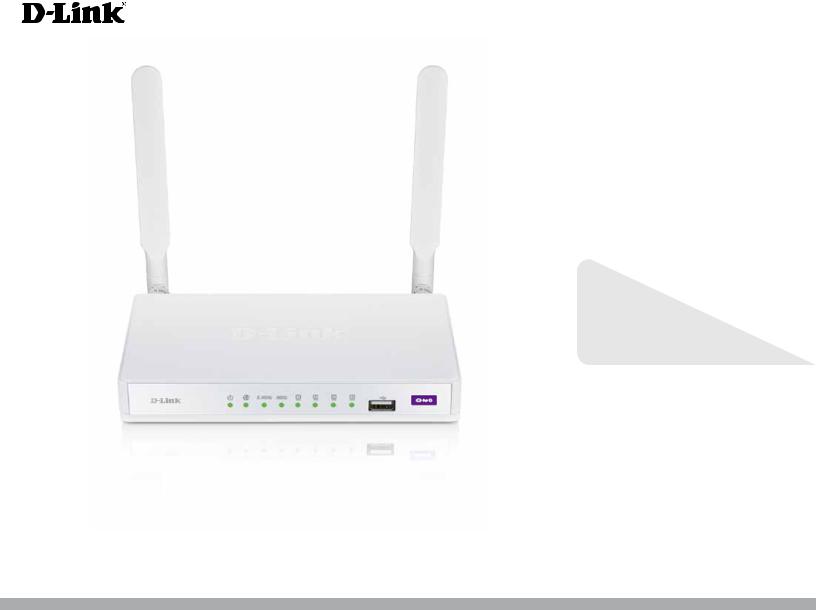
Version 1.0 | 11/06/2013
User Manual
Wireless N600 VPN Router
DIR-840
Downloaded from www.Manualslib.com manuals search engine

Preface
D-Link reserves the right to revise this publication and to make changes in the content hereof without obligation to notify any person or organization of such revisions or changes.
Manual Revisions
Revision |
Date |
Description |
1.0 |
November 06, 2013 |
• Initial release |
|
|
|
Trademarks
D-Link and the D-Link logo are trademarks or registered trademarks of D-Link Corporation or its subsidiaries in the United States or other countries. All other company or product names mentioned herein are trademarks or registered trademarks of their respective companies.
Copyright © 2013 by D-Link Corporation.
All rights reserved. This publication may not be reproduced, in whole or in part, without prior expressed written permission from D-Link Corporation.
D-Link DIR-840 User Manual |
i |
Downloaded from www.Manualslib.com manuals search engine

Table of Contents
Table of Contents
Preface.................................................................................. |
|
|
|
|
|
|
|
|
|
i |
Manual Revisions. |
........................................................................... i |
|||||||||
Trademarks. ...................................................................................... i |
||||||||||
ProductOverview............................................................... |
|
|
|
|
|
|
|
|
|
1 |
Package Contents. |
......................................................................... 1 |
|||||||||
System Requirements. |
................................................................. 2 |
|||||||||
Introduction. ................................................................................... 3 |
||||||||||
Features. ............................................................................................ 4 |
||||||||||
Hardware Overview. |
..................................................................... 5 |
|||||||||
Back............................................................................................ |
|
|
|
|
|
|
|
|
|
5 |
Front. .......................................................................................... |
|
|
|
|
|
|
|
|
|
6 |
Installation.......................................................................... |
|
|
|
|
|
|
|
|
|
7 |
Before you Begin. ........................................................................... 7 |
||||||||||
Wireless Installation Considerations. |
...................................... 8 |
|||||||||
Wall-Mount Kit Installation. |
....................................................... 9 |
|||||||||
Hardware Setup. |
..........................................................................10 |
|||||||||
Configuration.................................................................... |
|
|
|
|
|
|
|
|
|
12 |
Web Setup Wizard. |
......................................................................12 |
|||||||||
Web-based Configuration. Utility |
.......................................... |
17 |
||||||||
Internet Connection .Setup |
..................................................... |
|
|
18 |
||||||
Internet Connection Wizard. |
............................................18 |
|||||||||
Manual Internet Connection. |
..........................................20 |
|||||||||
Static (assigned by. ISP) ................................................ |
|
|
21 |
|||||||
Dynamic (DHCP). .............................................................22 |
||||||||||
PPPoE (DSL). ......................................................................23 |
||||||||||
PPTP. .................................................................................... |
|
|
|
|
|
|
|
|
|
25 |
L2TP. .................................................................................... |
|
|
|
|
|
|
|
|
|
27 |
3G. ........................................................................................ |
|
|
|
|
|
|
|
|
|
29 |
Wireless Settings. |
.........................................................................31 |
|||||||||
Wireless Setup Wizard. |
.......................................................32 |
|||||||||
WPS Connection Wizard. |
...................................................33 |
|||||||||
Manual Wireless Settings. |
.................................................35 |
|||||||||
Network Settings. |
........................................................................38 |
|||||||||
VPN Settings. .................................................................................39 |
||||||||||
VPN Setup Wizard. |
...............................................................39 |
|||||||||
Dynamic IPSec.VPN |
....................................................... |
|
|
|
40 |
|||||
IPSec VPN. ..........................................................................41 |
||||||||||
PPTP VPN. ...........................................................................42 |
||||||||||
L2TP VPN. ...........................................................................43 |
||||||||||
VPN Manual Settings. |
.........................................................44 |
|||||||||
IPSec Settings. ..................................................................45 |
||||||||||
PPTP/L2TP Settings. |
.......................................................47 |
|||||||||
GRE Settings. ....................................................................48 |
||||||||||
IPv6. .................................................................................................. |
|
|
|
|
|
|
|
|
|
49 |
Static IPv6. ..............................................................................50 |
||||||||||
Autoconfiguration. |
..............................................................51 |
|||||||||
PPPoE. ......................................................................................52 |
||||||||||
IPv6 over IPv4 Tunneling. |
..................................................53 |
|||||||||
6 to 4 Tunneling. ...................................................................54 |
||||||||||
6rd. ............................................................................................ |
|
|
|
|
|
|
|
|
|
55 |
Link-Local Connectivity. |
....................................................56 |
|||||||||
D-Link DIR-840 User Manual |
ii |
Downloaded from www.Manualslib.com manuals search engine

Table of Contents
IP Alias............................................................................................. |
|
|
|
|
|
57 |
Port Setting. ...................................................................................58 |
||||||
Virtual Computer. |
........................................................................59 |
|||||
Advanced.......................................................................... |
|
|
|
|
|
60 |
Virtual Server. ................................................................................60 |
||||||
Application Rules. |
........................................................................61 |
|||||
QoS Engine. ...................................................................................62 |
||||||
Network Filter. ..............................................................................64 |
||||||
Web Filter....................................................................................... |
|
|
|
65 |
||
Firewall Setting. ............................................................................66 |
||||||
Routing. ...........................................................................................68 |
||||||
Advanced Wireless. |
.....................................................................69 |
|||||
Wi-Fi Protected Setup. |
...............................................................70 |
|||||
Advanced Network Settings. |
...................................................71 |
|||||
Guest Zone. ....................................................................................72 |
||||||
IPv6 Firewall. ..................................................................................73 |
||||||
User Group. ....................................................................................74 |
||||||
Maintenance..................................................................... |
|
|
|
75 |
||
Admin. |
.............................................................................................75 |
|||||
Time. ................................................................................................. |
|
|
|
|
|
76 |
SysLog. |
.............................................................................................77 |
|||||
Email Settings. ..............................................................................78 |
||||||
System. ............................................................................................79 |
||||||
Firmware. |
........................................................................................80 |
|||||
Dynamic DNS. ...............................................................................81 |
||||||
System Check. ...............................................................................82 |
||||||
Schedule. |
........................................................................................83 |
|||||
Status................................................................................. |
|
84 |
Device Info. ....................................................................................84 |
||
Log. ................................................................................................... |
|
85 |
Statistics. .........................................................................................86 |
||
Active Session. ..............................................................................87 |
||
Wireless. ..........................................................................................88 |
||
Routing. ...........................................................................................89 |
||
VPN. .................................................................................................. |
|
90 |
IPv6. .................................................................................................. |
|
91 |
Support............................................................................. |
|
92 |
Troubleshooting............................................................... |
|
93 |
WirelessBasics.................................................................. |
|
97 |
Tips. ................................................................................................ |
|
100 |
Wireless Modes. ......................................................................... 101 |
||
NetworkingBasics.......................................................... |
|
102 |
Check your IP address. |
............................................................ 102 |
|
Statically Assign an IP address. |
............................................ 103 |
|
TechnicalSpecifications................................................. |
|
104 |
GPLCodeStatement ...................................................... |
|
105 |
SafetyStatements.......................................................... |
|
117 |
D-Link DIR-840 User Manual |
iii |
Downloaded from www.Manualslib.com manuals search engine

Section 1 - Product Overview
ProductPackageOverviewContents
DIR-840 Wireless N600 VPN Router
Two Detachable Antennas
Ethernet Cable
Power Adapter
Optional Wall-Mount Kit
If any of the above items are missing, please contact your reseller.
Note: Using a power supply with a different voltage rating than the one included with the DIR-840 will cause damage and void the warranty for this product.
D-Link DIR-840 User Manual |
1 |
Downloaded from www.Manualslib.com manuals search engine

Section 1 - Product Overview
System Requirements
NetworkRequirements |
• An Ethernet-based Cable or DSL modem |
• IEEE 802.11n or 802.11g wireless clients |
|
|
• 10/100/1000 Ethernet |
|
|
|
Computerwiththefollowing: |
|
• Windows®, Macintosh, or Linux-based operating system |
|
• An installed Ethernet adapter |
Web-basedConfiguration |
BrowserRequirements: |
• Internet Explorer 7 or higher |
|
UtilityRequirements |
• Firefox 12 or higher |
|
• Safari 4 or higher |
|
• Chrome 20 or higher |
|
Windows® Users: Make sure you have the latest version of Java |
|
installed. Visitwww.java.comto download the latest version. |
|
|
D-Link DIR-840 User Manual |
2 |
Downloaded from www.Manualslib.com manuals search engine

Section 1 - Product Overview
Introduction
ULTIMATEPERFORMANCE
The D-Link Wireless N600 VPN Router (DIR-840) is a 802.11n compliant device that delivers real world performance of up to 14x faster than an 802.11g wireless connection (also faster than a 100 Mbps wired Ethernet connection). Create a secure wireless network to share photos, files, music, video, printers, and network storage throughout your home. Connect the DIR-840 router to a cable or DSL modem and share your high-speed Internet access with everyone on the network. In addition, this router includes a Quality of Service (QoS) engine that keeps digital phone calls (VoIP) and online gaming smooth and responsive, providing a better Internet experience.
EXTENDED WIRELESSCOVERAGE
Powered by Wireless N technology, this high performance router provides superior home coverage throughout your home while reducing dead spots. The router is designed for use in bigger homes and for users who demand higher performance networking. Add a Wireless N notebook or desktop adapter and stay connected to your network from virtually anywhere in your home.
TOTALNETWORKSECURITY
The Wireless N router supports all of the latest wireless security features to prevent unauthorized access from over the wireless network or the Internet. Support for WPA/WPA2 standards ensure that you’ll be able to use the best possible encryption method, regardless of your client devices. In addition, this router utilizes dual active firewalls (SPI and NAT) to prevent potential attacks from across the Internet.
* Maximum wireless signal rate derived from IEEE Standard 802.11n specifications. Actual data throughput will vary. Network conditions and environmental factors, including volume of network traffic, building materials and construction, and network overhead, lower actual data throughput rate. Environmental conditions will adversely affect wireless signal range.
D-Link DIR-840 User Manual |
3 |
Downloaded from www.Manualslib.com manuals search engine

Section 1 - Product Overview
Features
•Faster Wireless Networking- The DIR-840 provides up to 300 Mbps* wireless connection with other 802.11n wireless clients. This capability allows users to participate in real-time activities online, such as video streaming, online gaming, and real-time audio. The performance of this 802.11n wireless router gives you the freedom of wireless networking at speeds 14x faster than 802.11g.
•Compatible with 802.11b/g/n Devices- The DIR-840 is still fully compatible with the IEEE 802.11b, 802.11g, and 802.11n standards, so it can connect with existing 802.11b, 802.11g, and 802.11n PCI, USB, and CardBus adapters.
•Advanced Firewall Features - The web-based user interface displays a number of advanced network management features including:
•Secure Multiple/Concurrent Sessions- The DIR-840 can pass through VPN sessions. It supports multiple and concurrent IPSec and PPTP sessions, so users behind the DIR-840 can securely access corporate networks.
•User-friendly SetupWizard -Through its easy-to-use web-based user interface, the DIR-840 lets you control what information is accessible to those on the wireless network, whether from the Internet or from your company’s server. Configure your router to your specific settings within minutes.
*Maximum wireless signal rate derived from IEEE Standard 802.11n specifications. Actual data throughput will vary. Network conditions and environmental factors, including volume of network traffic, building materials and construction, and network overhead, lower actual data throughput rate. Environmental conditions will adversely affect wireless signal range.
D-Link DIR-840 User Manual |
4 |
Downloaded from www.Manualslib.com manuals search engine
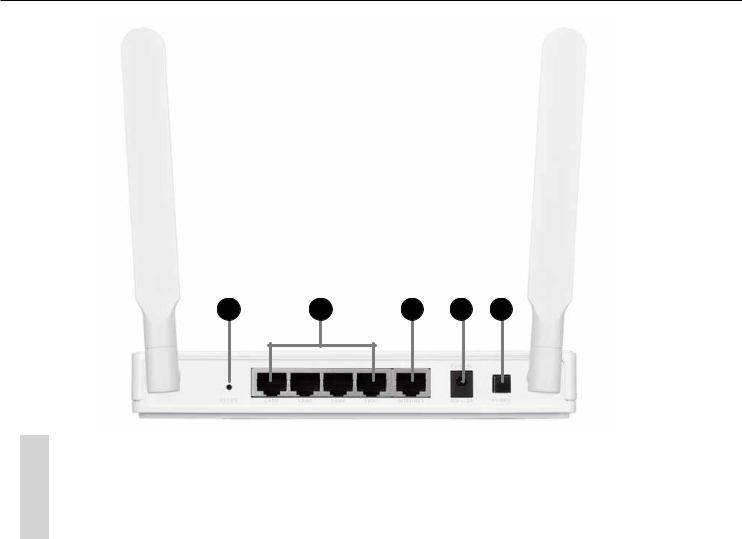
Section 1 - Product Overview
Hardware Overview
Back
1 |
2 |
3 |
4 |
5 |
|
1 |
LAN Ports (1-4) |
Connect 10/100 Ethernet devices such as computers, switches, and NAS. |
|
|
|
|
|
|
|
2 |
Internet Port |
The auto MDI/MDIX Internet port is the connection for the Ethernet cable to the cable or DSL modem. |
|
|
|
|
|
|
|
3 |
Reset Button |
Pressing the Reset button (for 3 seconds) restores the router to its original factory default settings. |
|
|
|
|
|
|
|
4 |
Power Receptor |
Receptor for the supplied power adapter. |
|
|
|
|
|
|
|
5 |
Power Button |
Turns the device On/Off. |
|
|
|
|
|
|
|
|
|
|
|
D-Link DIR-840 User Manual |
5 |
|||
Downloaded from www.Manualslib.com manuals search engine

Section 1 - Product Overview
Hardware Overview
Front
|
|
|
|
|
|
|
|
|
|
|
|
|
1 |
2 |
3 |
4 |
5 |
6 |
|
|
|
|
|
|
|
|
|
|
|
|
1 |
Power LED |
A solid light indicates a proper connection to the power supply. |
|
|||||
|
|
|
|
|
|
|
|
|
|
|
2 |
Internet LED |
A solid light indicates connection on the Internet port. This LED blinks during data transmission. |
|
|||||
|
|
|
|
|
|
|
|
|
|
|
3 |
WLAN LED (2.4 GHz) |
A solid light indicates that the 2.4 GHz wireless segment is ready. This LED blinks during wireless data |
|
|||||
|
transmission. |
|
|
|
|
|
|
||
|
|
|
|
|
|
|
|
|
|
|
4 |
WLAN LED (5 GHz) |
A solid light indicates that the 5 GHz wireless segment is ready. This LED blinks during wireless data |
|
|||||
|
transmission. |
|
|
|
|
|
|
||
|
|
|
|
|
|
|
|
|
|
|
5 |
LAN LEDs (1-4) |
A solid light indicates a connection to an Ethernet-enabled computer on ports 1-4. This LED blinks during |
|
|||||
|
data transmission. |
|
|
|
|
|
|
||
|
|
|
|
|
|
|
|
|
|
|
6 |
USB 2.0 port |
Allows you to connect 3G modems. |
|
|
|
|||
|
|
|
|
|
|
|
|
|
|
D-Link DIR-840 User Manual |
|
|
|
|
|
6 |
|||
Downloaded from www.Manualslib.com manuals search engine

Section 2 - Installation
Installation
This section will walk you through the installation process. Placement of the router is very important. Do not place the router in an enclosed area such as a closet, a cabinet, or in the attic or garage.
Before you Begin
•Please configure the router with the computer that was last connected directly to your modem.
•You can only use the Ethernet port on your modem. If you were using the USB connection before using the router, then you must turn off your modem, disconnect the USB cable and connect an Ethernet cable to the Internet port on the router, and then turn the modem back on. In some cases, you may need to call your ISP to change connection types (USB to Ethernet).
•If you have DSL and are connecting via PPPoE, make sure you disable or uninstall any PPPoE software such asWinPoET, BroadJump, or EnterNet 300 from your computer or you will not be able to connect to the Internet.
D-Link DIR-840 User Manual |
7 |
Downloaded from www.Manualslib.com manuals search engine

Section 2 - Installation
Wireless Installation Considerations
The D-Link wireless router lets you access your network using a wireless connection from virtually anywhere within the operating range of your wireless network. Keep in mind, however, that the number, thickness and location of walls, ceilings, or other objects that the wireless signals must pass through, may limit the range. Typical ranges vary depending on the types of materials and background RF (radio frequency) noise in your home or business. The key to maximizing wireless range is to follow these basic guidelines:
1.Keep the number of walls and ceilings between the D-Link router and other network devices to a minimum - each wall or ceiling can reduce your adapter’s range from 3-90 feet (1-30 meters.) Position your devices so that the number of walls or ceilings is minimized.
2.Be aware of the direct line between network devices. A wall that is 1.5 feet thick (.5 meters), at a 45-degree angle appears to be almost 3 feet (1 meter) thick. At a 2-degree angle it looks over 42 feet (14 meters) thick! Position devices so that the signal will travel straight through a wall or ceiling (instead of at an angle) for better reception.
3.Building materials make a difference. A solid metal door or aluminum studs may have a negative effect on range. Try to position access points, wireless routers, and computers so that the signal passes through drywall or open doorways. Materials and objects such as glass, steel, metal, walls with insulation, water (fish tanks), mirrors, file cabinets, brick, and concrete will degrade your wireless signal.
4.Keep your product away (at least 3-6 feet or 1-2 meters) from electrical devices or appliances that generate RF noise.
5.If you are using 2.4 GHz cordless phones or X-10 (wireless products such as ceiling fans, lights, and home security systems), your wireless connection may degrade dramatically or drop completely. Make sure your 2.4 GHz phone base is as far away from your wireless devices as possible. The base transmits a signal even if the phone in not in use.
D-Link DIR-840 User Manual |
8 |
Downloaded from www.Manualslib.com manuals search engine
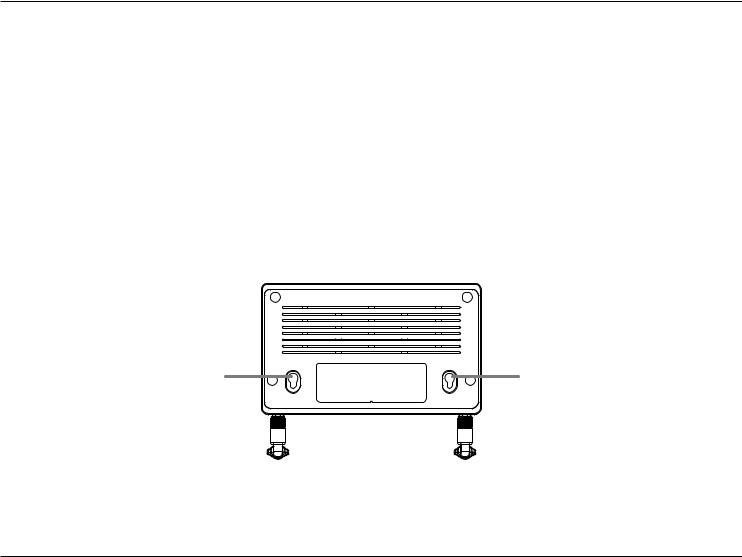
Section 2 - Installation
Wall-Mount Kit Installation
The wall-mount kit includes the following items:
-Two 2 cm screws
-Two screw anchors
-One attachment plate
Step 1. Align the attachment plate to your preferred position, and mark the hole positions on the wall, preferably after locating studs in the wall.
Step 2. Where studs cannot be found, make holes in the wall and insert the provided screw anchors. Check that the screw anchors are securely in place.
Step 3. Securely screw down the attachment plate on the wall.
Wall mount hole |
Wall mount hole |
|
DIR-840 |
Step 4. Hang the router on the wall by sliding the tops of the screws through the holes on the bottom of the router and then slide to lock into position. Confirm the the router is firmly in place.
D-Link DIR-840 User Manual |
9 |
Downloaded from www.Manualslib.com manuals search engine
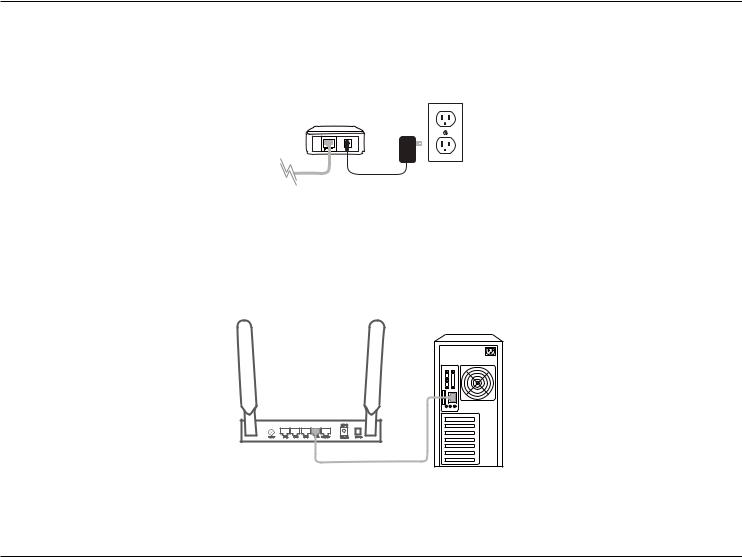
Section 2 - Installation
Hardware Setup
1. Turn off and unplug your cable or DSL broadband modem. This is required.
Modem
2.Position your router close to your modem and a computer. Place the router in an open area of your intended work area for better wireless coverage.
3.Unplug the Ethernet cable from your modem (or existing router if upgrading) that is connected to your computer. Plug it into the blue port labeled 1 on the back of your router. The router is now connected to your computer.
DIR-840
INTERNET
Computer |
D-Link DIR-840 User Manual |
10 |
Downloaded from www.Manualslib.com manuals search engine
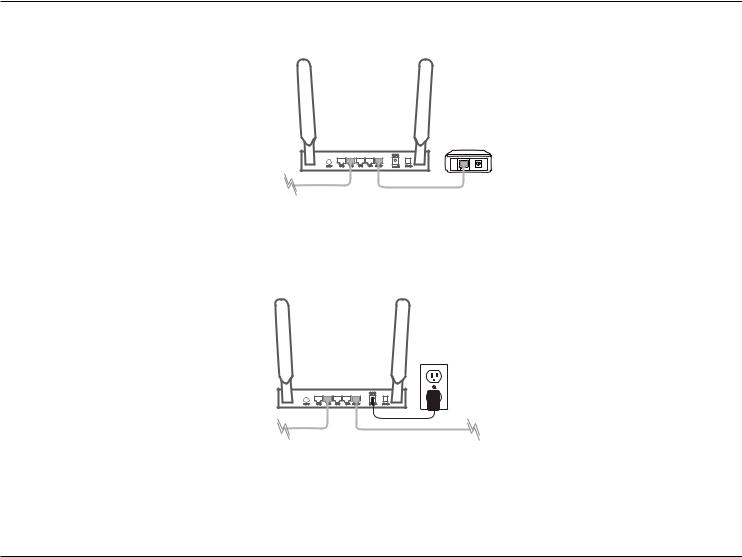
Section 2 - Installation
4.Plug one end of the included blue Ethernet cable that came with your router into the yellow port labeled INTERNET on the back of the router. Plug the other end of this cable into the Ethernet port on your modem.
DIR-840 |
Modem |
5.Reconnect the power adapter to your cable or DSL broadband modem and wait for two minutes.
6.Connect the supplied power adapter into the power port on the back of the router and then plug it into a power outlet or surge protector. Press the power button and verify that the power LED is lit. Allow 1 minute for the router to boot up.
DIR-840
7.If you are connecting to a broadband service that uses a dynamic connection (not PPPoE), you may be online already. Try opening a web browser and enter a web site. If you connect, you are finished with your Internet setup. Please skip to page 17 to configure your router and use the manual setup procedure to configure your network and wireless settings. If you did not connect to the Internet, use the Web Setup Wizard (refer to page 12).
D-Link DIR-840 User Manual |
11 |
Downloaded from www.Manualslib.com manuals search engine

Section 3 - Setup
Configuration
Web Setup Wizard
Open your web browser and the setup wizard will automatically launch.
Step 1: The Welcome screen will appear. Click Next to continue.
Step 2: The router will automatically detect your Internet connection type.
Step3: If the router could not automatically detect your connection type, select your connection type and click Next to continue.
D-Link DIR-840 User Manual |
12 |
Downloaded from www.Manualslib.com manuals search engine
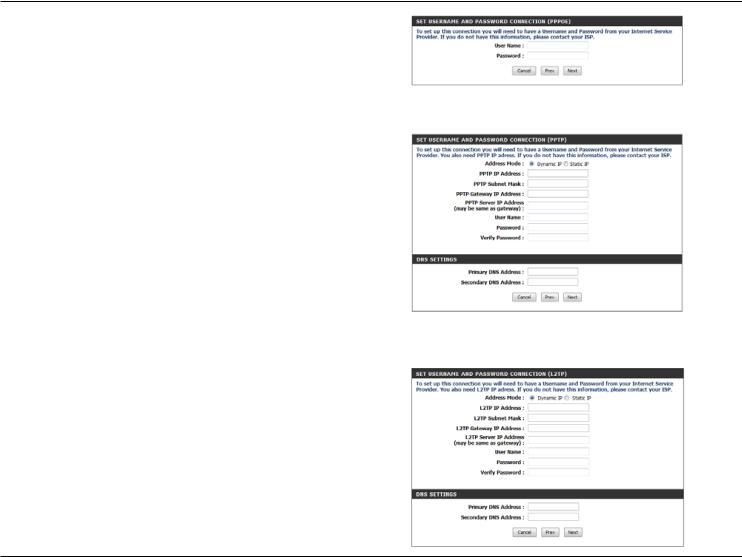
Section 3 - Setup
If you selected PPPoE, enter your PPPoE username and password.
ClickNexto continue.
Note: Make sure to remove your PPPoE software from your computer. The software is no longer needed and will not work through a router.
If you selected PPTP, enter your PPTP settings supplied by your ISP and your PPTP username and password. Click Next to continue.
If you selected L2TP, enter your L2TP settings supplied by your ISP and your L2TP username and password. Click Next to continue.
D-Link DIR-840 User Manual |
13 |
Downloaded from www.Manualslib.com manuals search engine
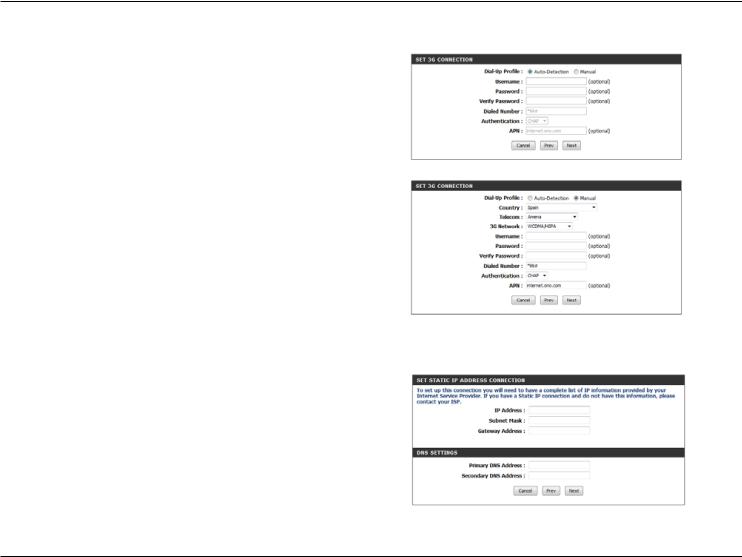
Section 3 - Setup
If you selected 3g, in most cases you can choose Auto-Detection to get a connection.
Otherwise choose Manual and fill in the settings provided by your 3g network provider.
Click Next to continue.
If you selected Static, enter your network settings supplied by your
Internet provider. Click Next to continue.
D-Link DIR-840 User Manual |
14 |
Downloaded from www.Manualslib.com manuals search engine
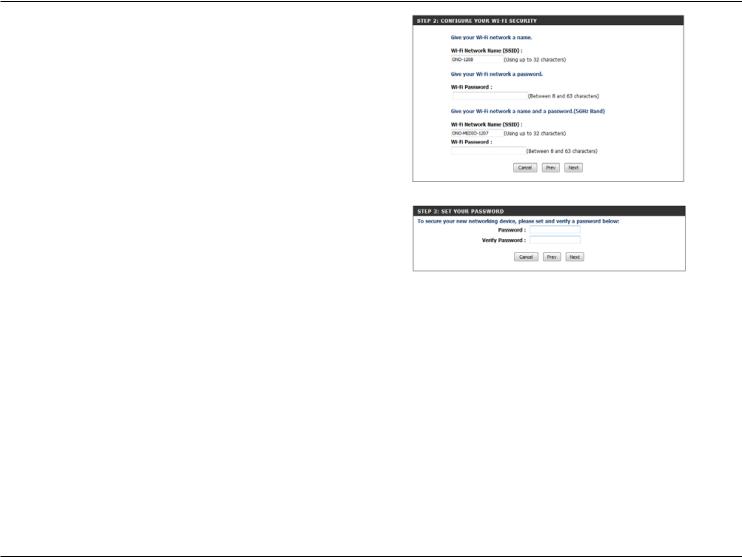
Section 3 - Setup
Step 4: Create a name for your wireless network (SSID), create a password for your wireless network (Wi-Fi password), and then click Next to continue.
Step 5: Create a new password and then click Next to continue.
D-Link DIR-840 User Manual |
15 |
Downloaded from www.Manualslib.com manuals search engine
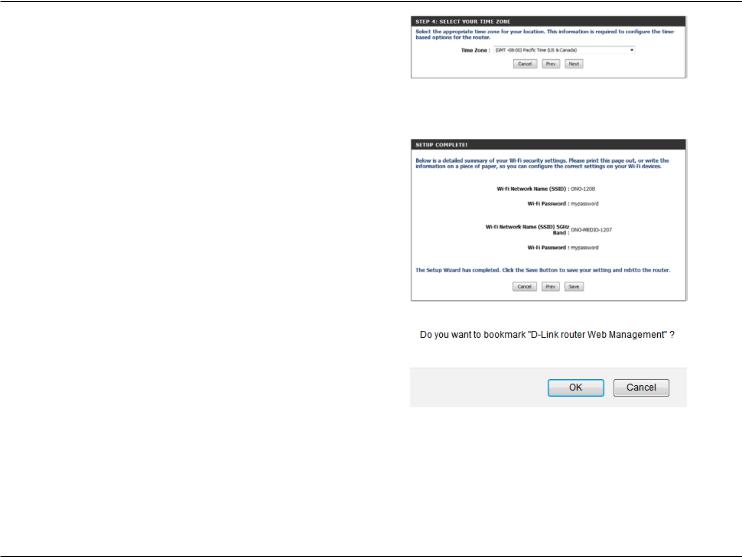
Section 3 - Setup
Step 6:Select your time zone from the drop-down menu and then clickNexto continue.
Step7:Your setup is completeSave. Clickto continue.
Step 8: You may bookmark the router’s web UI by clicking OK. If you do not want to bookmark theCancellink, click.
The router will reboot. Please allow 1-2 minutes.
Close your browser window and reopen it to test your Internet connection. It may take a few tries to initially connect to the Internet.
D-Link DIR-840 User Manual |
16 |
Downloaded from www.Manualslib.com manuals search engine
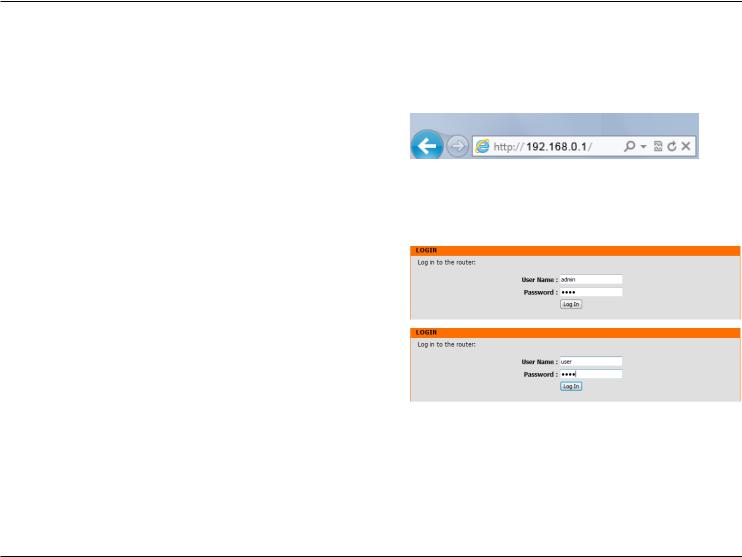
Section 3 - Setup
Web-based Configuration Utility
To access the configuration utility, open a web-browser such as Internet Explorer and enter the IP address of the router (http://192.168.or0.1usehttp://dlinkrouter.)local. .
You will be presented with the login screen.The default usernames and passwords are as follows:
Web Root User Type admin in the User Name field and the password
(Public): should be1234.
Web User Type user in the User Name field and the password should
(Read Only): beuser.
D-Link DIR-840 User Manual |
17 |
Downloaded from www.Manualslib.com manuals search engine
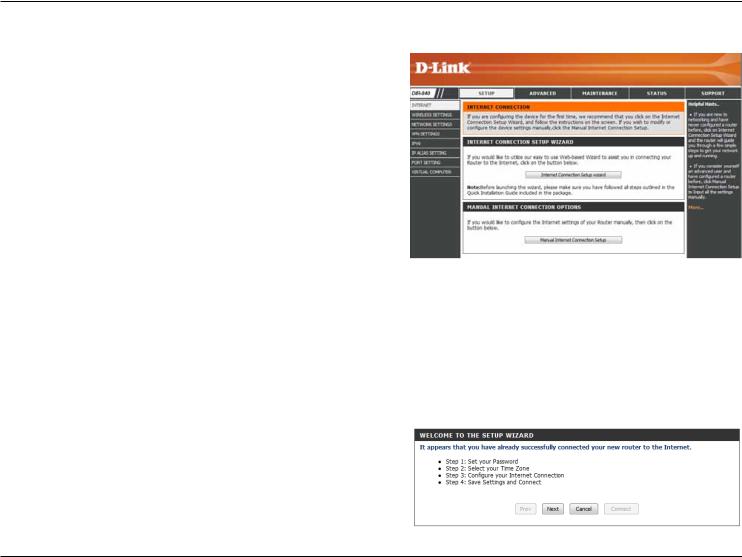
Section 3 - Setup
Internet Connection Setup
Use this tab to choose if you want to follow the simple steps of the Connection Setup Wizard, or if you want to set up your Internet connection manually.
Internet Connection Wizard
ClickNexto begin the Setup Wizard.
D-Link DIR-840 User Manual |
18 |
Downloaded from www.Manualslib.com manuals search engine
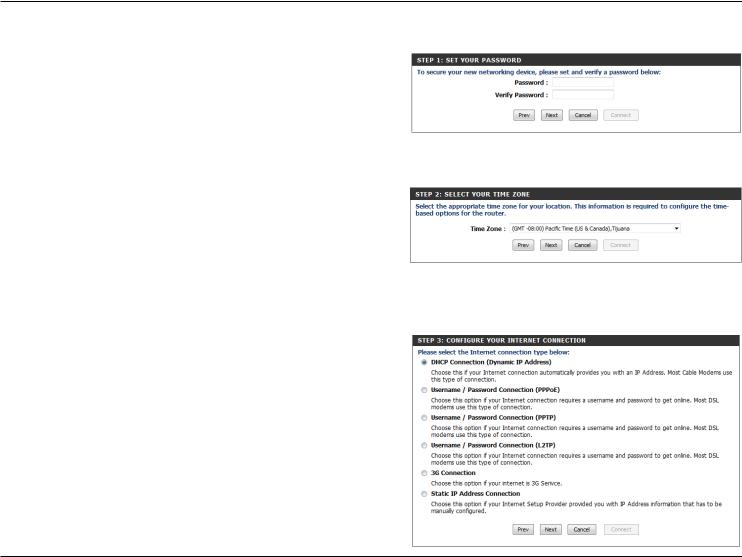
Section 3 - Setup
STEP1:Choose a password for your device.
STEP2:Select your time zone from the drop-down menu.
STEP 3:Choose the method you use to connect to the Internet, and follow the step-by-step instructions.
D-Link DIR-840 User Manual |
19 |
Downloaded from www.Manualslib.com manuals search engine
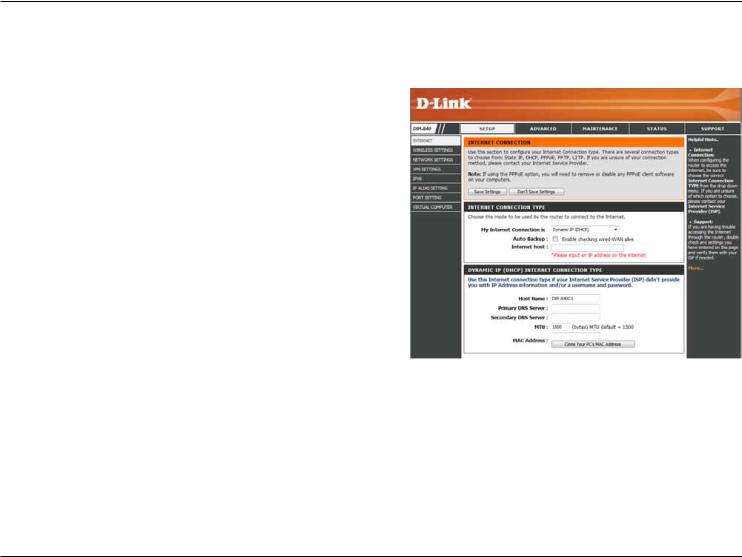
Section 3 - Setup
Manual Internet Connection
Use this tab to choose either Static IP, DHCP, PPPoE, PPTP, L2TP, or 3G to configure your Internet connection. You may need to get this information from your ISP (Internet Service Provider).
D-Link DIR-840 User Manual |
20 |
Downloaded from www.Manualslib.com manuals search engine
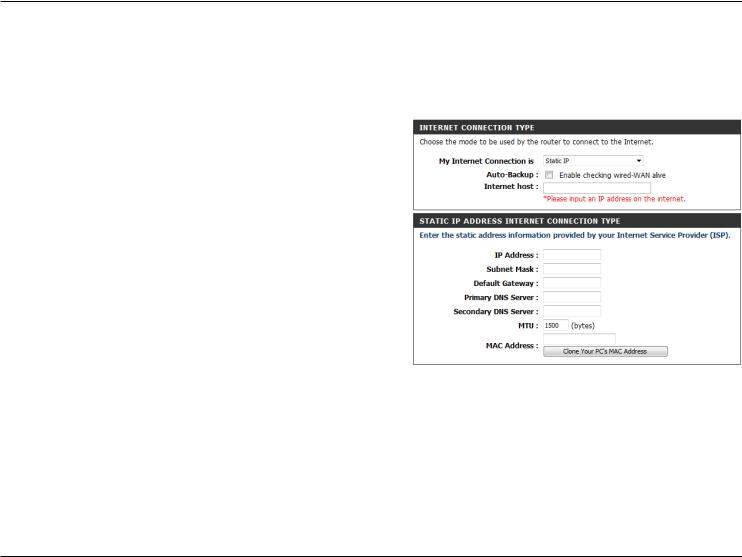
Section 3 - Setup
Static (assigned by ISP)
Select Static IP if all the Internet port’s IP information is provided to you by your ISP. You will need to enter in the IP address, subnet mask, gateway address, and DNS address(es) provided to you by your ISP. Each IP address entered in the fields must be in the appropriate IP form, which are four octets separated by a dot (x.x.x.x). The router will not accept the IP address if it is not in this format.
My Internet Select Static IPto manually enter the IP settings supplied
Connection Is: by your ISP.
Auto-Backup: Check the box to enable a backup connection.
Internet Host: If you enabled Auto-Backup, enter the IP address of the backup connection.
IP Address: Enter the IP address assigned by your ISP.
Subnet Mask: Enter the subnet mask assigned by your ISP.
Default Gateway: Enter the gateway assigned by your ISP.
DNS Servers: The DNS server information will be supplied by your ISP (Internet Service Provider.)
MTU: Maximum Transmission Unit - you may need to change the MTU for optimal performance with your specific ISP. 1500 is the default MTU.
MAC Address: The default MAC address is set to the Internet port’s physical interface MAC address on the broadband router. It is not recommended that you change the default MAC address unless required by your ISP. You can use the Clone Your PC’s MAC Address button to replace the Internet port’s MAC address with the MAC address of your Ethernet card.
D-Link DIR-840 User Manual |
21 |
Downloaded from www.Manualslib.com manuals search engine
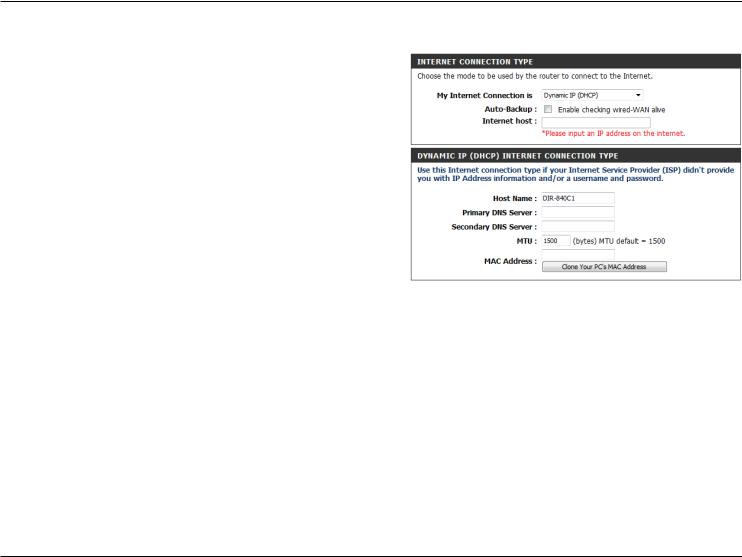
Section 3 - Setup
Dynamic IP (DHCP)
My Internet SelectDynamicIP(DHCP)toobtainIPaddressinformation Connection Is: automatically from your ISP. Select this option if your ISP does not give you any IP numbers to use. This option is
commonly used for cable modem services.
Auto-Backup: Check the box to enable a backup connection.
Internet Host: If you enabled Auto-Backup, enter the IP address of the backup connection.
Primary/Secondary Enter the primary and secondary DNS server IP addresses DNS Server: assigned by your ISP.These addresses are usually obtained automatically from your ISP. Leave at 0.0.0.0 if you did not
specifically receive these from your ISP.
MTU: Maximum Transmission Unit - you may need to change the MTU for optimal performance with your specific ISP. 1500 is the default MTU.
MAC Address: The default MAC Address is set to the Internet port’s physical interface MAC address on the broadband router. It is not recommended that you change the default MAC address unless required by your ISP. You can use the
Clone Your PC’s MAC Address button to replace the Internet port’s MAC address with the MAC address of your Ethernet card.
D-Link DIR-840 User Manual |
22 |
Downloaded from www.Manualslib.com manuals search engine
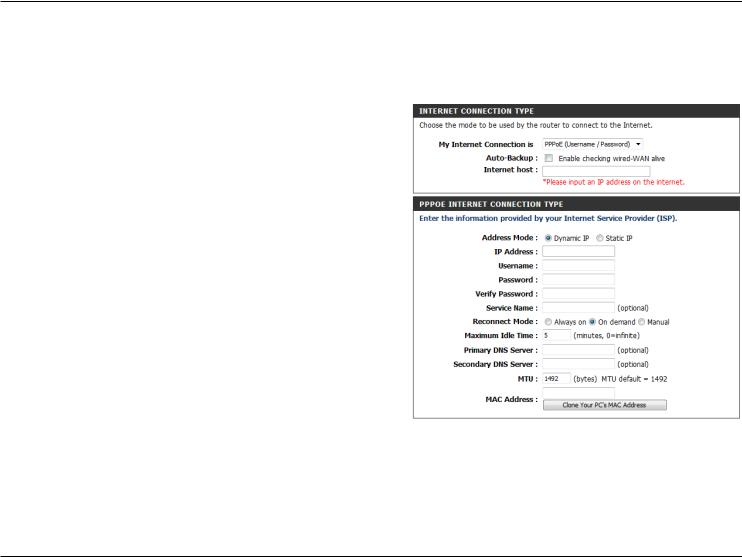
Section 3 - Setup
PPPoE (DSL)
Choose PPPoE (Point to Point Protocol over Ethernet) if your ISP uses a PPPoE connection. Your ISP will provide you with a username and password. This option is typically used for DSL services. Make sure to remove your PPPoE software from your computer. The software is no longer needed and will not work through a router.
My Internet Select PPPoE (Username/Password)from the drop-down
Connection Is: menu.
Auto-Backup: Check the box to enable a backup connection.
Internet Host: If you enabled Auto-Backup, enter the IP address of the backup connection.
Address Mode: Select Static IP if your ISP assigned you the IP address, subnet mask, gateway, and DNS server addresses. In most cases, selectDynamicIP.
IP Address: Enter the IP address (Static PPPoE only).
User Name: Enter your PPPoE user name.
Password: Enter your PPPoE password and then retype the password in the next box.
Service Name: Enter the ISP service name (optional).
Reconnect Select eitherAlways-on, On-Demand, orManual.
Mode:
Maximum Idle Enter a maximum idle time during which the Internet Time: connection is maintained during inactivity. To disable this
feature, enable Auto-reconnect.
D-Link DIR-840 User Manual |
23 |
Downloaded from www.Manualslib.com manuals search engine
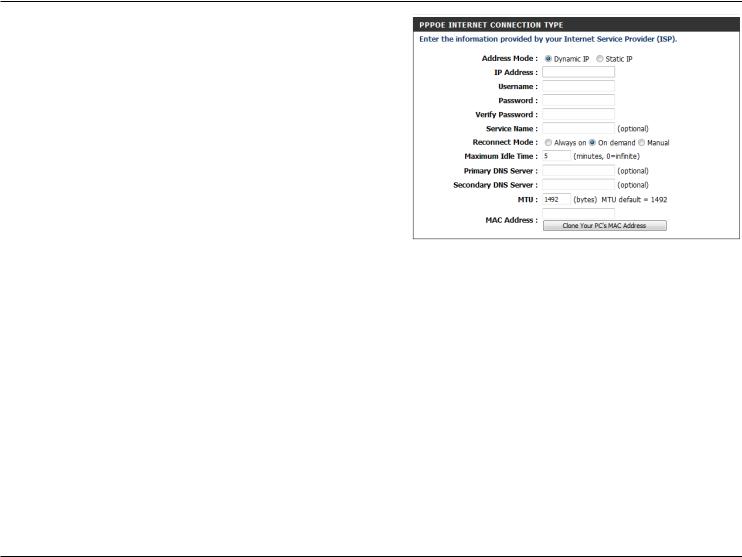
Section 3 - Setup
DNS Addresses: Enter the primary and secondary DNS server addresses (Static PPPoE only).
MTU: Maximum Transmission Unit - you may need to change the MTU for optimal performance with your specific ISP. 1492 is the default MTU.
MAC Address: The default MAC address is set to the Internet port’s physical interface MAC address on the broadband router. It is not recommended that you change the default MAC address unless required by your ISP. You can use the Clone Your PC’s MAC Address button to replace the Internet port’s MAC address with the MAC address of your Ethernet card.
D-Link DIR-840 User Manual |
24 |
Downloaded from www.Manualslib.com manuals search engine

Section 3 - Setup
PPTP
Choose PPTP if your ISP uses a PPTP connection. Your ISP will provide you with a username and password.
My Internet SelectPPTPfrom the drop-down menu.
Connection Is:
Address Mode: Select Static IP if your ISP assigned you the IP address, subnet mask, gateway, and DNS server addresses. In most cases, selectDynamicIP.
PPTP IP Address: Enter the IP address for your PPTP connection.
PPTP Subnet Mask: Enter your PPTP subnet mask.
PPTP Gateway IP Enter the gateway IP address for your PPTP connection.
Address:
PPTP Server IP Enter the server IP address for your PPTP connection.
Address:
User Name: Enter your PPTP user name.
Password: Enter your PPTP password and then retype the password in the next box.
Reconnect Mode: Select eitherAlways-on, On-Demand, orManual.
Maximum Idle Enter a maximum idle time during which the Internet Time: connection is maintained during inactivity. To disable this
feature, enable Auto-reconnect.
DNS Addresses: Enter the primary and secondary DNS server addresses (Static PPTP only).
D-Link DIR-840 User Manual |
25 |
Downloaded from www.Manualslib.com manuals search engine
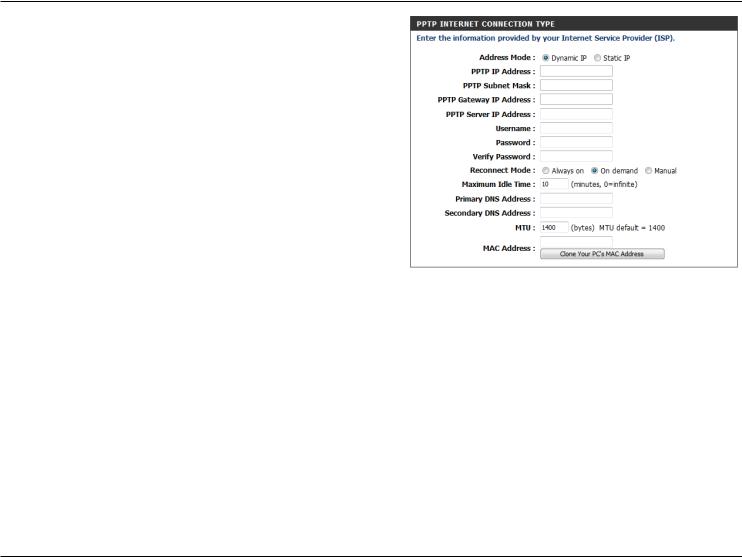
Section 3 - Setup
MTU: Maximum Transmission Unit - you may need to change the MTU for optimal performance with your specific ISP. 1492 is the default MTU.
MAC Address: The default MAC address is set to the Internet port’s physical interface MAC address on the broadband router. It is not recommended that you change the default MAC address unless required by your ISP. You can use the Clone Your PC’s MAC Address button to replace the Internet port’s MAC address with the MAC address of your Ethernet card.
D-Link DIR-840 User Manual |
26 |
Downloaded from www.Manualslib.com manuals search engine
